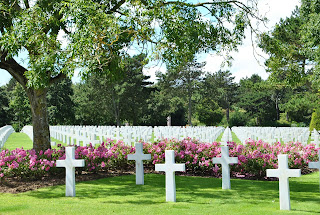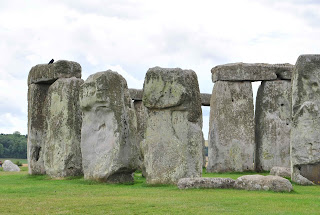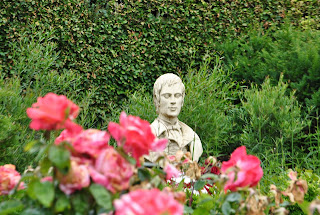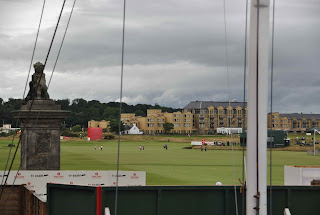...and a surprise ending to the trip.
We awoke on Saturday morning to somewhat cloudy skies and
cool temperatures, but even the disembodied clearance announcement voice was
saying that the expected high temperature for the day would be about 22 degrees
- and for once he wasn't calling for rain!
We had spent part of Friday afternoon getting a head start
on the packing, since today's tour to the landing beaches in Normandy would be
a long day and not allow much time before dinner to get it all done. And so,
knowing we were prepared ahead of schedule, we set out for the last two-hour
one-way bus ride of this trip. We haven't even tried to add up all the time we
spent on tour buses; it would probably boggle the mind!
We had thought we'd have to travel a good way up the Seine
River before we'd be able to cross to the western side and head toward the
beaches. We hadn't, however, considered that the French would be one step ahead
of us. Only a short distance outside of the huge port at Le Havre, we came upon
le Pont Normandie, the Normandy Bridge, that crosses only about 6 miles below
the mouth of the Seine, and very close to the old town of Honfleur. If you go
back to the posts from our river cruise in 2009, you'll see our photos of the
town - from which Samuel de Champlain departed when he sailed down the St.
Lawrence River and founded Quebec.
The only problem we noticed with the bridge was that,
although the rest is state-of-the-art, it still had manual toll collectors that
tended to back things up a little. Something that we would really notice on the
way back. Once across the bridge, we set
off toward the beach area.
When traveling through some of the small towns near the
beaches, it was easy to see that the locals still show a lot of appreciation
for the efforts and the losses that the Allies Forces experienced on D-Day;
there are quite a few homes with British, American and Canadian flags flying
along with their own. It certainly does give a person pause to look out over the
rolling hillside, now covered with wheat or flax or cattle or sheep, and try to
picture how it must have looked when the troops marched and rolled across the
same land after having finally conquered the beachhead and the cliffs to fight
for France's freedom.
The first memorial of sorts we passed was at Juno Beach,
where there is a Canadian museum to the D-Day effort made by our forces. This is the new building:
Our first actual stop was in the town of Arromanche, where
the Allies built the Mulberry Harbour to support the ground troops moving
through France. Larry had, of course, been rereading (for the twelfth time
perhaps) Stephen Ambrose's book, D-Day, so he was quite well-versed on the
whole operation. Good thing, since our tour guide was great when she was
reading from her prepared script about D-Day, but had lots of trouble answering
off-the-cuff questions posed by our bus-mates. So although Larry only had an
audience of one (guess who) when we looked over the caissons now half-submerged
at high tide, whenever anyone around us had a question, he was quite ready to
answer it.
We had some extra time around the town, and took a few more
photos. Unlike many of the other towns in the beach area, Arromanche was not
destroyed by the Germans or by the bombing from naval forces. It had been
liberated from the land side at the same time as the Allies pretty much
destroyed the German air forces, so most of the old buildings date back before
the war.
After Arromanche, we had lunch at an absolutely gorgeous old
farmhouse outside the town. It is now a small hotel, and the buildings
themselves date back to the 14th century. Lunch was French cheese that is
sliced and for all intents broiled to warm and soften it. Delicious! Our main
course was a local staple: Poulet à la Normande, chicken breast in a mushroom
cream sauce, served with boiled fingerling potatoes, veggies and a half a baked
apple. The apple was really no surprise, as Normandy is known as the apple
orchard capital of France, and the département we were in, Calvados, is renowned
for the apple-based brandy that bears the region's name. Calvados is made from
fermenting apple cider the same way as you would ferment grape juice to make brandy.
Here are a few photos of the farm:
 |
| Another beautiful house in the country |
After lunch, we headed off to the American Cemetery at Omaha
Beach, the beach at Vierville, and Pointe d'Hoc. We had been to all these
places before, but this time instead of walking down to the beach at Omaha, we
spent some more time at the top, looking at the memorials and some of the
gravestones. There was even one whose name Larry recognized from some of his
reading on the event. Rather than rehashing the full descriptions, we'll just
post a few photos:
 |
| The diarama overlooking Omaha Beach |
 |
| The Monument to the US 'Big Red One' at Omaha |
 |
| The monument on the beach at Vierville to the US National Guard unit that lost 85% of its men on D-Day |
 |
| Overlooking Pointe d'Hoc. Each of these craters was caused by a shell fired from at sea, most from the US battleship 'Texas'. |
 |
| The cliffs that the US Rangers scaled using rope ladders and the like. |
Walking back to the bus at the end of the tour, we agreed
that we were officially finished, for this trip anyway, with long tours that
required a lot of walking sandwiched between long bus rides. This had been
quite a busy itinerary with very little downtime. Next time we're in the
British Isles - and we will definitely be back - we're going to tour around our
port cities. Most of them have Hop On Hop Off Bus tours that would fit the bill
perfectly!
Our last evening on board was actually quite relaxed. We had
put our luggage out before dinner, saving the one small suitcase to carry off
with us so we wouldn't have to try to
cram our clothes and things into our carry-ons. We had met a really nice couple
from Sydney, Australia when we happened to be seated at the same table two
nights before. We met them again at the wine bar on Friday and all dinner
together for a second night. Then, as if Fate had decreed that we hadn't spent
enough time together (7:30 until 10:00, being almost the last ones out of the
dining room both nights), they happened to be waiting for a table at the same
time we were, and the hostess seated us together again! We're pretty sure the
staff couldn't wait to see the backs of us for this cruise, since we were there
until 10:00 for the third night in a row!
Bright and early at 8:00 this morning, Eddie, our driver, was waiting to
drive us to the airport. We had asked if there would be enough time to make
a bit of a detour. He agreed and, instead of going directly to Heathrow, we
took a scenic drive through Wiltshire (another one of those areas Monica has
wanted to see) to run through the town of Salisbury. The whole area, not just
the city, bear a closer look, but here are some pictures of what we saw: |
| The gate into the Cathedral Close in Salisbury |
 |
| One of the beautiful houses in rural Wiltshire |
 |
| A manor house |
We stopped for a few minutes outside the Bridge Inn overlooking the River Avon. Eddie was joking that the ducks have started to recognize his car, since they showed up almost as soon as we got out!
 |
| Swans on the river |
And after that, our next stop was the highlight of the
morning, and one of those places that you never think you'll actually get to
see - Stonehenge.
Although the photos you always see make it look absolutely
immense, in fact it is really rather small, and this was Larry's first comment.
The highest stones are about 30 feet high, including the lintels at the top. But
still the engineering and technology that they used 3,000 years ago when it was
built are still amazing. As is the fact that its true use is still a mystery
all these years later. We spent about a half hour walking around and taking
photos before climbing back into the bus for the trip to the airport.
We are finally posting this from home. Although we started
working on this post at the airport there wasn't enough time to finish it, and
no power plug for the computer on the plane so we could finish writing before
the battery ran out, and post at home.
So, once again, we hope you enjoyed our reports and pictures
as much as we enjoyed writing and deciding which would be our 'blog shots'. See
you next time in southern California as we do the Pacific Coast Drive and a
coastal cruise with Norm and Barb.








































.JPG)
.JPG)














































